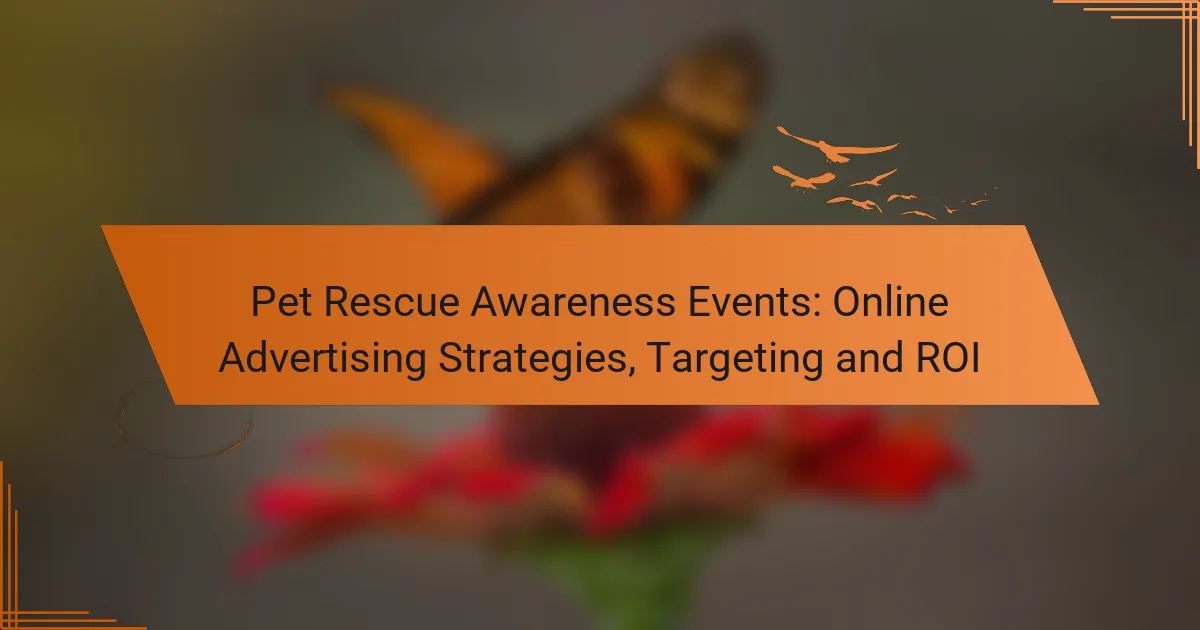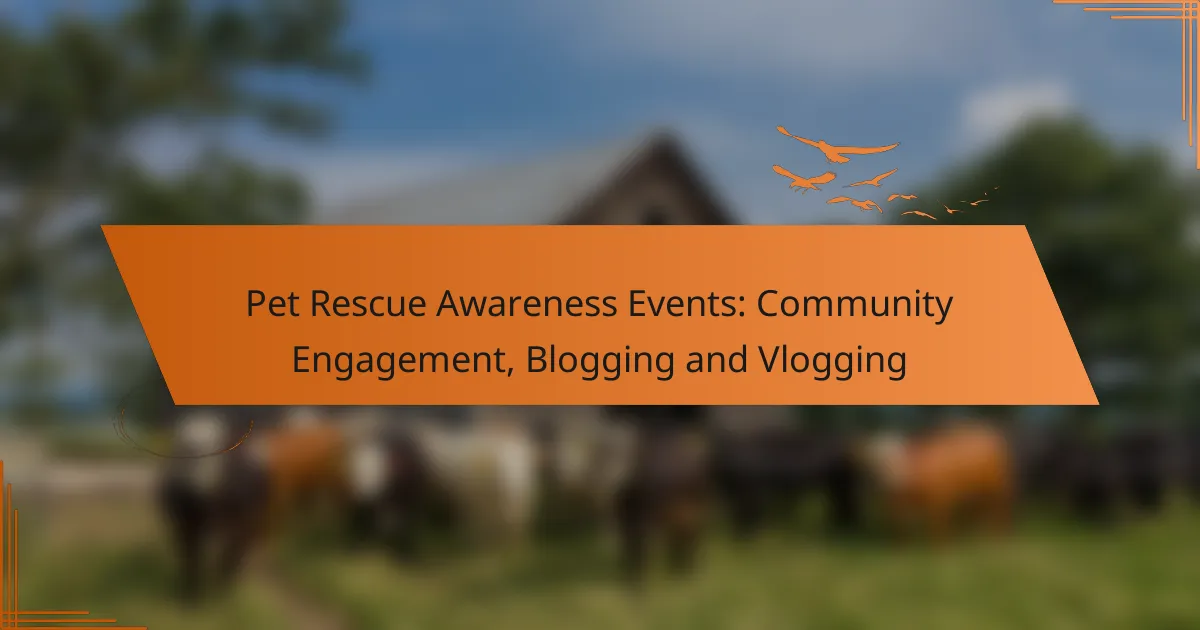Online advertising plays a crucial role in enhancing the visibility and engagement of pet rescue awareness events. By utilizing targeted strategies across various digital platforms, organizations can effectively reach their desired audience, communicate their mission, and drive participation, ultimately maximizing their return on investment.
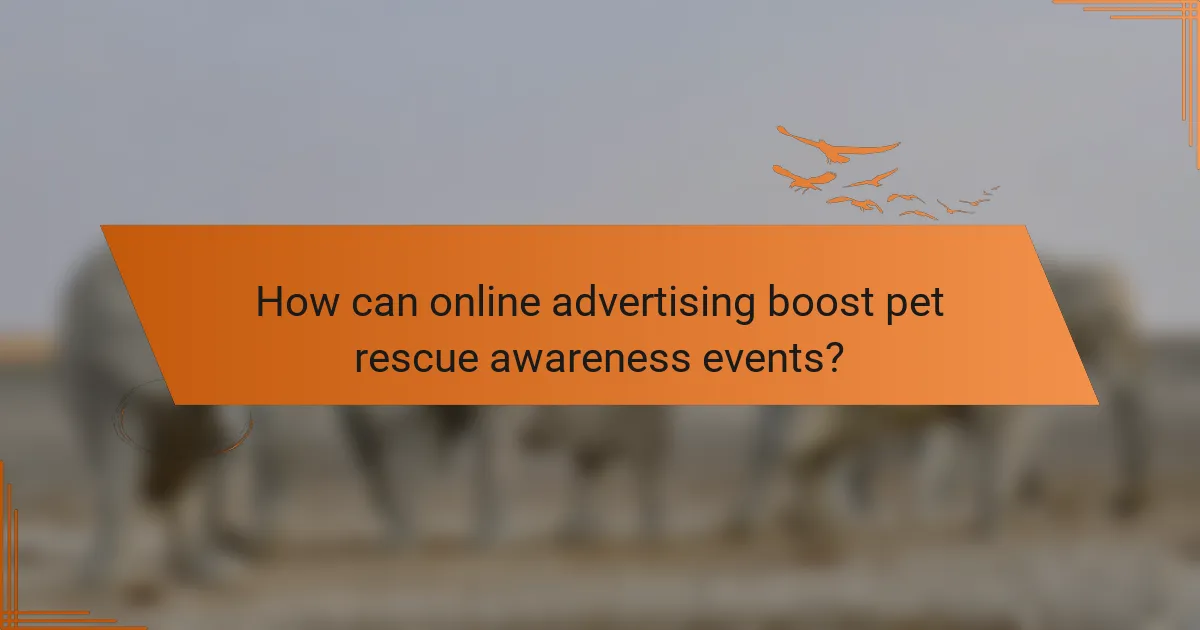
How can online advertising boost pet rescue awareness events?
Online advertising can significantly enhance the visibility and engagement of pet rescue awareness events. By leveraging various digital platforms, organizations can reach a broader audience, effectively communicate their mission, and drive participation.
Increased visibility through social media ads
Social media ads are a powerful tool for increasing awareness of pet rescue events. Platforms like Facebook and Instagram allow organizations to target specific demographics, ensuring that the ads reach individuals who are most likely to support animal welfare.
To maximize impact, use eye-catching visuals and compelling calls to action. Consider allocating a budget of a few hundred dollars to run ads over a couple of weeks leading up to the event, which can yield significant engagement and participation.
Targeted email marketing campaigns
Email marketing is an effective way to directly reach supporters of pet rescue initiatives. By segmenting your email list based on previous interactions or interests, you can tailor messages that resonate with specific groups, enhancing the likelihood of attendance.
Design your emails to include clear event details, engaging stories about the animals involved, and a strong call to action. Aim for a frequency of one to two emails per week as the event approaches, but avoid overwhelming recipients to maintain interest.
Utilizing Google Ads for local outreach
Google Ads can help pet rescue organizations target local communities effectively. By using location-based keywords and geo-targeting, ads can appear to users searching for pet-related events or services in their area.
Set a modest daily budget to test different ad copies and keywords, adjusting based on performance. Focus on specific phrases like “pet adoption events near me” to attract local participants. Regularly monitor the campaign to optimize for better results and ensure that the ads align with the event’s goals.

What are effective targeting strategies for pet rescue events?
Effective targeting strategies for pet rescue events focus on reaching the right audience through demographic, geographic, and interest-based criteria. By honing in on specific groups, organizations can maximize engagement and increase the return on investment (ROI) from their advertising efforts.
Demographic targeting based on pet ownership
Demographic targeting involves identifying potential attendees based on pet ownership status. This can include targeting individuals who currently own pets, as well as those who have expressed interest in adopting. Utilizing data from surveys or social media insights can help refine this approach.
Consider segmenting your audience further by age, income, or family status, as these factors can influence pet ownership and adoption rates. For example, families with children may be more inclined to adopt a pet, making them a key demographic for outreach.
Geographic targeting in urban areas
Geographic targeting focuses on specific locations, particularly urban areas where pet ownership is often higher. Advertising in cities can yield better results due to the concentration of potential adopters. Utilize local social media groups, community boards, and event listings to reach these audiences effectively.
When planning your campaigns, consider the unique characteristics of different neighborhoods. For instance, affluent areas may have higher disposable income for pet care, while lower-income neighborhoods may benefit from targeted outreach that emphasizes affordable adoption options.
Interest-based targeting for animal lovers
Interest-based targeting allows you to reach individuals who have shown a passion for animals, whether through online behavior or engagement with related content. Platforms like Facebook and Instagram offer tools to target users based on their interests, such as animal welfare, pet care, and rescue organizations.
To enhance this strategy, consider creating engaging content that resonates with animal lovers, such as heartwarming rescue stories or educational posts about pet care. This can help build a community around your event and encourage sharing, further expanding your reach.

What is the ROI of online advertising for pet rescue events?
The return on investment (ROI) of online advertising for pet rescue events can vary widely based on factors like campaign strategy, target audience, and engagement levels. Generally, effective online advertising can yield significant returns in terms of donations and increased awareness, often ranging from a few hundred to several thousand dollars for each dollar spent.
Measuring engagement through click-through rates
Click-through rates (CTR) are a crucial metric for assessing engagement in online advertising campaigns for pet rescue events. A higher CTR indicates that your ads resonate with the audience, prompting them to take action. Aim for a CTR of around 2-5% for effective campaigns, but this can vary based on the platform and ad quality.
To improve CTR, focus on compelling ad copy and eye-catching visuals that highlight the mission of your pet rescue. A/B testing different headlines and images can help identify what drives more clicks.
Calculating conversion rates for donations
Conversion rates measure the percentage of users who take a desired action, such as donating after clicking on an ad. For pet rescue events, a typical conversion rate might range from 1-5%, depending on the effectiveness of your landing page and the appeal of your cause. Tracking this metric helps you understand the financial impact of your advertising efforts.
To enhance conversion rates, ensure your donation process is simple and user-friendly. Consider offering multiple donation options and clearly communicating how contributions will be used to support animals in need.
Assessing brand awareness through surveys
Surveys can be an effective tool for gauging brand awareness following online advertising campaigns for pet rescue events. By asking participants about their familiarity with your organization before and after the campaign, you can measure changes in awareness levels. Aim to survey a representative sample of your target audience to obtain reliable data.
Incorporate questions that assess recognition of your brand and its mission. This feedback can guide future advertising strategies and help you refine your messaging to better connect with potential supporters.
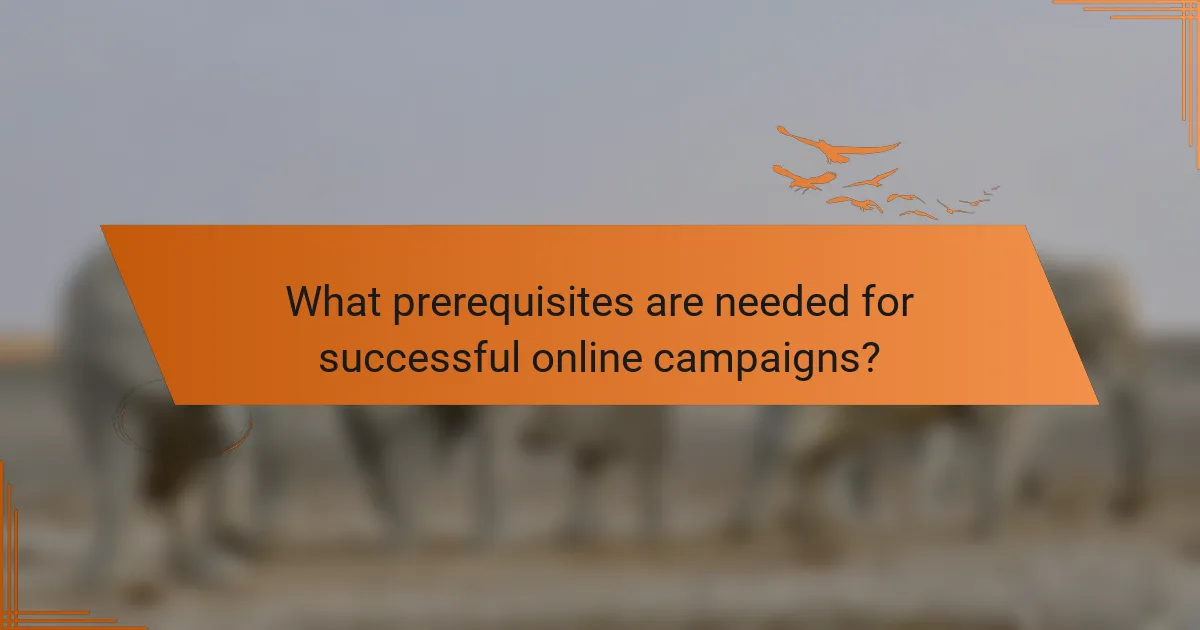
What prerequisites are needed for successful online campaigns?
Successful online campaigns for pet rescue awareness require a clear understanding of your objectives and a well-defined budget. These prerequisites help ensure that your advertising efforts are focused and effective, maximizing your return on investment (ROI).
Establishing a clear campaign goal
Defining a clear campaign goal is essential for guiding your online advertising strategy. Goals can range from increasing event attendance to boosting donations or raising awareness about specific rescue animals. Make sure your objectives are specific, measurable, achievable, relevant, and time-bound (SMART).
For example, instead of a vague goal like “increase awareness,” aim for “increase social media engagement by 30% within three months.” This clarity will help you tailor your messaging and select appropriate advertising channels.
Creating a budget for advertising spend
Establishing a budget for your advertising spend is crucial for managing costs and maximizing ROI. Determine how much you can allocate based on your overall fundraising goals and the expected outcomes of your campaign. A common practice is to allocate around 10-20% of your total fundraising target to advertising.
Consider breaking down your budget into specific categories, such as social media ads, Google Ads, and promotional materials. This approach allows you to track spending effectively and adjust your strategy based on performance metrics.
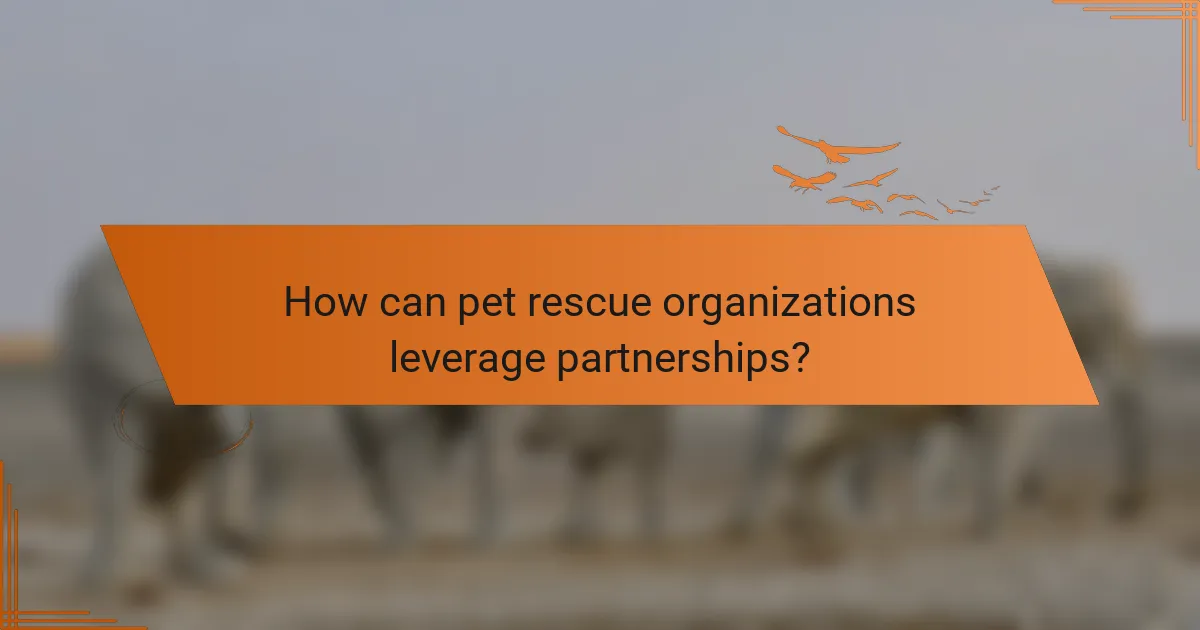
How can pet rescue organizations leverage partnerships?
Pet rescue organizations can enhance their outreach and fundraising efforts by forming strategic partnerships with local businesses and influencers in the pet community. These collaborations can amplify visibility, attract new supporters, and ultimately drive donations.
Collaborating with local businesses for sponsorships
Partnering with local businesses can provide pet rescue organizations with essential sponsorships that support events and initiatives. Businesses may offer financial backing, in-kind donations, or promotional support in exchange for advertising opportunities, such as featuring their logo on event materials.
To initiate these partnerships, organizations should identify businesses that align with their mission and values, such as pet supply stores or veterinary clinics. Proposing a mutually beneficial arrangement can help secure sponsorships that enhance both the business’s visibility and the organization’s fundraising goals.
Engaging influencers in the pet community
Influencers in the pet community can significantly boost awareness and engagement for pet rescue organizations. By collaborating with popular pet bloggers or social media personalities, organizations can reach a broader audience and attract potential adopters and donors.
When engaging influencers, it’s crucial to select those whose values resonate with the organization’s mission. Offering them opportunities to share stories about rescue animals or participate in events can create authentic connections that inspire their followers to support the cause.

What are the best practices for content creation in ads?
Effective content creation in ads for pet rescue awareness events involves using engaging visuals and emotionally resonant storytelling. These elements help capture attention, convey the mission, and drive action from potential supporters.
Using compelling visuals of rescued pets
Compelling visuals are crucial in ads as they evoke emotions and create a connection with the audience. High-quality images or videos of rescued pets can showcase their personalities and the impact of the rescue efforts. Consider using before-and-after photos to highlight transformations and success stories.
When selecting visuals, ensure they are bright, clear, and well-composed. Use images that depict pets in happy, loving environments to reinforce the positive outcomes of adoption. Incorporating user-generated content, such as photos from adopters, can also enhance authenticity and relatability.
Crafting emotional storytelling in ad copy
Emotional storytelling in ad copy can significantly enhance engagement and motivate action. Start by sharing a brief narrative about a specific rescued pet, detailing their journey and the challenges they faced. This personal touch can resonate deeply with potential supporters.
Use descriptive language that evokes empathy and urgency, encouraging readers to take action, whether it’s donating, volunteering, or adopting. Highlighting the broader impact of their support on the lives of other animals can also strengthen the emotional appeal. Keep the tone sincere and hopeful to inspire positive responses.

What are emerging trends in online advertising for non-profits?
Emerging trends in online advertising for non-profits include innovative strategies that enhance engagement and reach. These trends focus on leveraging new technologies and formats to connect with audiences more effectively.
Increased use of video content
Video content has become a vital tool for non-profits, allowing them to tell compelling stories and showcase their impact visually. Platforms like Facebook and Instagram prioritize video, making it essential for organizations to create short, engaging clips that highlight their missions.
To maximize effectiveness, aim for videos that are under two minutes long, as viewers tend to lose interest beyond that. Incorporating testimonials from beneficiaries or showcasing rescue events can create emotional connections that drive donations.
Integration of augmented reality experiences
Augmented reality (AR) is gaining traction in online advertising, providing immersive experiences that can captivate potential supporters. Non-profits can use AR to create interactive campaigns that allow users to visualize the impact of their contributions, such as seeing a virtual pet in need of rescue.
Implementing AR requires careful planning and investment in technology, but it can significantly enhance user engagement. Consider partnering with AR developers to create experiences that are easy to access via smartphones, ensuring a broad audience reach.
